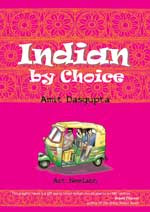A discovery of India
Lalita Panicker, Hindustan Times
May 09, 2009
Chicago meets chole bhature with predictable results. Mandy, not Mandeep, a second-generation Indian from America comes slumming it to India for a cousin’s wedding. His journey of self-discovery, indeed the discovery of India, is told in Amit Dasgupta’s innovatively illustrated book Indian by Choice. So what’s new, you may ask. Nothing, except that Dasgupta weaves Mandy’s rollercoaster ride with his boisterous Punjab family and his encounters with a riotous, often rude, India into a narrative that is at once beguiling and humorous.
Now and again, some sage relative gives Mandy a sermon on Indian civilisation and culture. Soon, his revulsion for the heaving Indian masses with their intrusive questions and gratituous comments gives way to a desire to learn more about this bewildering land. Through the eyes of his adopted cousin Simrita, his prejudices slowly dissolve and he begins to understand what makes India tick. Dasgupta’s strength lies in his simple storytelling. He shows up India with all its warts at the same time as he shows up Mandy’s irrational prejudices and his desire to downplay his Indianness. Admittedly, some parts of the beautifully illustrated book border on the naïve, but what the hell. We are like that only.
The book deals with a dilemma that most immigrant Indian families face. The parents are reluctant to let go of their roots, often clinging to them with needless ferocity. They often force their children to go back to their native land and imbibe the local culture. The children having been born and brought up abroad invariable loathe their encounters with an alien land. After all, they have spent all their lives erasing their Indian identities, to the extent, like Mandy, of changing their names.
But Dasgupta’s saga of Mandy has a happy ending. The young man, traumatized at first, is won over by his relatives and their persuasive discourses. Here and there, Dasgupta hints at a burgeoning romance between Mandy and his fetching cousin Simrita. In his effort to encompass Indian culture in its entirety in his book, he introduces a couple of Bengali characters as well. Well, the book would have been khub bhalo without the mandatory Bengali dialogue.
Subscribe to:
Post Comments (Atom)

No comments:
Post a Comment